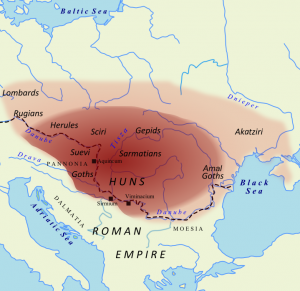Attila the Hun was born north of the Danube in the early 5th century AD. Some records indicate his birth to be around 406 AD though it is still debated because others assert proposed birthdates to be around the 390s. Due to the Huns lacking a written history, most accounts are from other cultures or their enemies, especially when Hunnic people preferred oral means to transmit their literature and knowledge. Nevertheless, some records provide some insights into the birthplace and ancestry of the Hunnic ruler.
Birthplace
The Danube basin is home to different early human cultures and different empires that had to cross for various purposes, from expansion to trade. It is within this region where Attila was said to be born. Some accounts report Pannonia, north and east of Danube, as the actual birthplace of the Hunnic king and was a Roman province in Transdanubia, Hungary.
In the 2nd century AD, the Romans divided Pannonia, and, in the 4th to 5th century AD, the empire built the Diocese of Pannonia with the capital city known as Sirmium. Although the specific city of Attila’s birthplace is unknown, it is likely to be within this province.
Ancestry
The Huns were nomadic people who lived in Central Asia, Eastern Europe, and the Caucasus, or the region between the Black Sea and the Caspian Sea. Generally, Attila’s ancestry begins with the origins of the Hunnic people. However, their origins remain uncertain, except with the culture originating in Central Asia. Some classical sources assert these people appeared suddenly around 370 AD in Europe. Roman writers equated the Huns with earlier steppe peoples.
- Origins of the Huns
The origins of the Huns provide a look into Attila’s ancestry at a longer scope. Based on research in genetics, Hunnic males studied have a mix of East Asian and European ancestry. These findings coincide with some attesting the Huns have relations or origins with the Xiongnu people. The Xiongnu were a tribal confederation of nomads which inhabited the Eurasian Steppe from the 3rd century BC to the 1st century AD.
However, ancient sources point out how the Hunnic people have ties with their ancestry to those who lived in present-day Afghanistan and its neighboring areas. These groups of people are called Iranian Huns, which included Xionites, Kidarites, Hephthalites, Nezaks, and Huna. However, these claims of connections have been a subject of scholarly controversy. The strongest theories of the origins of Huns are with the Xiongnu.
- Ethnic descent and parentage
In other perspectives of ancestry, one aspect of consideration is ethnic background. According to some studies, the Huns were divided into Asian and European groups. The former stayed where it originated in Asia, while the latter moved westward to Europe. Both are said to have origins from the Mongolian ethnicity, while others note a mixture of Turks and Mongols. However, linguistic and historical evidence argued that European Huns, of which Attila is part, were descendants of Asian Huns of Turkic origin. Based on different views, patterns indicate Attila to be of Asian origin, whether in Central or Eastern Asia.
In terms of family, not much is known, but there are indications that Attila was from noble lineage. His father is Mundzuk (370-420), but his mother is unknown. His uncles, Octar and Ruga, ruled the Hunnic Empire. Hence, they were the predecessors of Attila and Bleda, his half-brother and co-ruler of the Hun Empire. One of his grandparents is known, namely Kuridak (336-411). Other aspects of Attila’s background are unknown as of yet.
